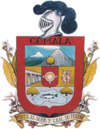Comala, Colima
| Comala | ||
|---|---|---|
| Town & Municipality | ||

Main Plaza and church
|
||
|
||
| Location in Mexico | ||
| Coordinates: 19°19′15″N 103°45′37″W / 19.32083°N 103.76028°WCoordinates: 19°19′15″N 103°45′37″W / 19.32083°N 103.76028°W | ||
| Country |
|
|
| State | Colima | |
| Founded | 1550s | |
| Municipal Status | 1856 | |
| Government | ||
| • Municipal President | Sergio Agustín Morales Anguiano | |
| Area | ||
| • Municipality | 254 km2 (98 sq mi) | |
| Elevation (of seat) | 600 m (2,000 ft) | |
| Population (2005) Municipality | ||
| • Municipality | 19,495 | |
| • Seat | 8,927 | |
| Time zone | CST (UTC-6) | |
| Postal code (of seat) | 28450 | |
| Area code(s) | 312 | |
| Website |
www |
|
Comala (Spanish ![]() [koma'la] )is a town and municipality located in the Mexican state of Colima, near the state capital of Colima. It has been nicknamed the “White Village of America” as the facades of the buildings in town have all been painted white since the 1960s. The historic center of the town was declared a Historic Monument Zone and the town became a Pueblo Mágico in 2002. It is the municipal seat of the Comala Municipality, the local governing authority for over 400 other communities, including the former Nogueras Hacienda, the home of artist Alejandro Rangel Hidalgo.
[koma'la] )is a town and municipality located in the Mexican state of Colima, near the state capital of Colima. It has been nicknamed the “White Village of America” as the facades of the buildings in town have all been painted white since the 1960s. The historic center of the town was declared a Historic Monument Zone and the town became a Pueblo Mágico in 2002. It is the municipal seat of the Comala Municipality, the local governing authority for over 400 other communities, including the former Nogueras Hacienda, the home of artist Alejandro Rangel Hidalgo.
Historically, Comala has been a small agricultural village/town. At the beginning of the 20th century, the town had only three streets around the main square. It is also associated with Juan Rulfo’s novel Pedro Páramo, although it is not known if Rulfo was referring to the town directly in the novel. The town is still surrounded by papaya, banana, , almond and palm orchards, with orange and palm trees found within for decoration. It is possible to see the Volcano of Colima from the town. Many of the older buildings, especially in the town center have walls made of adobe, and many of the houses have small yards with flowers guarded by iron fences. The historic center of the town was declared a Historic Monument Zone by presidential decree in 1988 and is distinguished by streets paved with river stone. In 1961, the town decided to paint itself white as a way to distinguish itself from the surrounding communities. Today, it is filled with structures with white walls and red tile roofs.
...
Wikipedia


